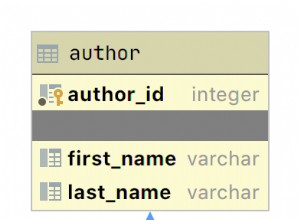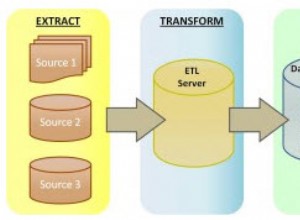Esta é uma variação de um problema de lacunas e ilhas, com a complicação adicional do número máximo de linhas em cada ilha. Isso é um pouco prolixo, mas você pode começar identificando os grupos causados pela ordem da sequência:
select t.*,
row_number() over (partition by "Description" order by "Start") as rn,
case when lag("SequentialOrder")
over (partition by "Description" order by "Start") < "SequentialOrder"
then 1 else 0 end as newblock
from test t
order by "Start";
Start Description MaximunRow SequentialOrder RN NEWBLOCK
--------- ----------- ---------- --------------- --- ----------
12-JUN-15 A 3 3 1 0
13-JUN-15 A 3 4 2 1
14-JUN-15 A 3 5 3 1
01-JUL-15 A 3 4 4 0
02-JUL-15 A 3 3 5 0
04-JUL-15 A 3 4 6 1
01-AUG-15 B 2 5 1 0
16-AUG-15 B 2 7 2 1
Você pode então usar um CTE recursivo (a partir de 11gR2) com base nisso:
with u as (
select t.*,
row_number() over (partition by "Description" order by "Start") as rn,
case when lag("SequentialOrder")
over (partition by "Description" order by "Start") < "SequentialOrder"
then 1 else 0 end as newblock
from test t
),
r ("Start", "Description", "MaximunRow", "SequentialOrder", rn, blocknum,
pos, lastmaxrow) as (
select u."Start", u."Description", u."MaximunRow", u."SequentialOrder", u.rn,
1, 1, u."MaximunRow"
from u
where rn = 1
union all
select u."Start", u."Description", u."MaximunRow", u."SequentialOrder", u.rn,
case when r.pos = r.lastmaxrow or u.newblock = 0
then r.blocknum + 1 else r.blocknum end,
case when r.pos = r.lastmaxrow or u.newblock = 0
then 1 else r.pos + 1 end,
case when r.pos = r.lastmaxrow or u.newblock = 0
then r.lastmaxrow else u."MaximunRow" end
from r
join u on u."Description" = r."Description" and u.rn = r.rn + 1
)
select * from r
order by "Start";
Start Description MaximunRow SequentialOrder RN BLOCKNUM POS LASTMAXROW
--------- ----------- ---------- --------------- --- ---------- ---- ----------
12-JUN-15 A 3 3 1 1 1 3
13-JUN-15 A 3 4 2 1 2 3
14-JUN-15 A 3 5 3 1 3 3
01-JUL-15 A 3 4 4 2 1 3
02-JUL-15 A 3 3 5 3 1 3
04-JUL-15 A 3 4 6 3 2 3
01-AUG-15 B 2 5 1 1 1 2
16-AUG-15 B 2 7 2 1 2 2
Isso está atribuindo um
blocknum para cada linha, começando em um para cada descrição no membro âncora e sendo incrementado no membro recursivo se o newblock é zero (indicando uma quebra de sequência) ou o número de membros no bloco é o máximo anterior. (Talvez eu não tenha a lógica para 'máximo anterior' muito certa, pois não está claro na pergunta.) Você pode então agrupar pela descrição e o número do bloco gerado:
with u as (
select t.*,
row_number() over (partition by "Description" order by "Start") as rn,
case when lag("SequentialOrder")
over (partition by "Description" order by "Start") < "SequentialOrder"
then 1 else 0 end as newblock
from test t
),
r ("Start", "Description", "MaximunRow", "SequentialOrder", rn, blocknum,
pos, lastmaxrow) as (
select u."Start", u."Description", u."MaximunRow", u."SequentialOrder", u.rn,
1, 1, u."MaximunRow"
from u
where rn = 1
union all
select u."Start", u."Description", u."MaximunRow", u."SequentialOrder", u.rn,
case when r.pos = r.lastmaxrow or u.newblock = 0
then r.blocknum + 1 else r.blocknum end,
case when r.pos = r.lastmaxrow or u.newblock = 0
then 1 else r.pos + 1 end,
case when r.pos = r.lastmaxrow or u.newblock = 0
then r.lastmaxrow else u."MaximunRow" end
from r
join u on u."Description" = r."Description" and u.rn = r.rn + 1
)
select min(r."Start") as "Start", max(r."Start") as "End", r."Description"
from r
group by r."Description", r.blocknum
order by r."Description", r.blocknum;
Start End Description
--------- --------- -----------
12-JUN-15 14-JUN-15 A
01-JUL-15 01-JUL-15 A
02-JUL-15 04-JUL-15 A
01-AUG-15 16-AUG-15 B
Seus dados de amostra não acionam a quebra máxima de linhas, pois você não tem nenhuma sequência maior que 3 de qualquer maneira. Com alguns dados adicionais:
Insert into TEST ("Start","Description","MaximunRow","SequentialOrder") values (to_date('15-JUN-15','DD-MON-RR'),'A',3,7);
Insert into TEST ("Start","Description","MaximunRow","SequentialOrder") values (to_date('16-JUN-15','DD-MON-RR'),'A',3,8);
Insert into TEST ("Start","Description","MaximunRow","SequentialOrder") values (to_date('17-JUN-15','DD-MON-RR'),'A',3,10);
Insert into TEST ("Start","Description","MaximunRow","SequentialOrder") values (to_date('18-JUN-15','DD-MON-RR'),'A',3,12);
Insert into TEST ("Start","Description","MaximunRow","SequentialOrder") values (to_date('19-JUN-15','DD-MON-RR'),'A',3,13);
a mesma consulta obtém:
Start End Description
--------- --------- -----------
12-JUN-15 14-JUN-15 A
15-JUN-15 17-JUN-15 A
18-JUN-15 19-JUN-15 A
01-JUL-15 01-JUL-15 A
02-JUL-15 04-JUL-15 A
01-AUG-15 16-AUG-15 B
para que você possa ver que está se dividindo na mudança de sequência e ao acertar três linhas no bloco.
Demonstração do SQL Fiddle .
Você pode se safar apenas com o CTE recursivo, e não com o intermediário anterior, comparando a ordem sequencial diretamente nas instruções case em vez de usar
newblock; mas tendo rn encontrar a próxima linha é mais fácil do que tentar encontrar a próxima data, pois elas não são contíguas. 



